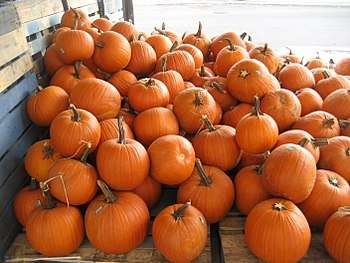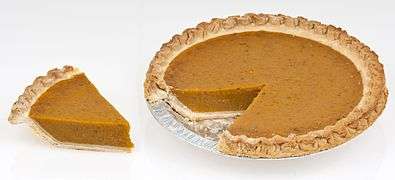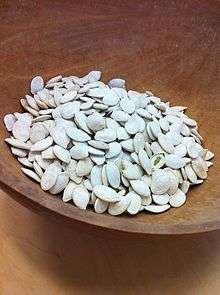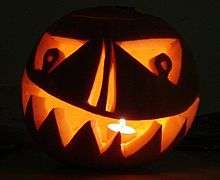Pumpkin
A pumpkin is a cultivar of winter squash that is round with smooth, slightly ribbed skin, and most often deep yellow to orange in coloration.[1] The thick shell contains the seeds and pulp. The name is most commonly used for cultivars of Cucurbita pepo, but some cultivars of Cucurbita maxima, C. argyrosperma, and C. moschata with similar appearance are also sometimes called "pumpkin".[1]

Native to North America (northeastern Mexico and the southern United States),[1] pumpkins are one of the oldest domesticated plants, having been used as early as 7,500 to 5,000 BC.[1] Pumpkins are widely grown for commercial use and as food, aesthetics, and recreational purposes. Pumpkin pie, for instance, is a traditional part of Thanksgiving meals in Canada and the United States, and pumpkins are frequently carved as jack-o'-lanterns for decoration around Halloween, although commercially canned pumpkin purée and pumpkin pie fillings are usually made from different kinds of winter squash than the ones used for jack-o'-lanterns.[1]


Etymology and terminology
The word pumpkin originates from the word pepon (πέπων), which is Greek for "large melon", something round and large.[2] The French adapted this word to pompon, which the British changed to pumpion and to the later American colonists became known as pumpkin.[3]
The term pumpkin has no agreed upon botanical or scientific meaning,[4] and is used interchangeably with "squash" and "winter squash".[1] In North America and the United Kingdom, pumpkin traditionally refers to only certain round orange varieties of winter squash, predominantly derived from Cucurbita pepo, while in New Zealand and Australian English, the term pumpkin generally refers to all winter squash.[5]
Description
Pumpkins, like other squash, originated in northeastern Mexico and southern United States.[1] The oldest evidence were pumpkin fragments dated between 7,000 and 5,500 BC found in Mexico.[1] Pumpkin fruits are a type of botanical berry known as a pepo.[1][6]

Traditional C. pepo pumpkins generally weigh between 3 and 8 kilograms (6 and 18 lb), though the largest cultivars (of the species C. maxima) regularly reach weights of over 34 kg (75 lb).[7]
The color of pumpkins derives from orange carotenoid pigments, including beta-cryptoxanthin, alpha and beta carotene, all of which are provitamin A compounds converted to vitamin A in the body.[8]
Taxonomy
All pumpkins are winter squash, mature fruit of certain species in the genus Cucurbita. Characteristics commonly used to define "pumpkin" include smooth and slightly ribbed skin,[9] and deep yellow to orange[9] color. Circa 2005, white pumpkins had become increasingly popular in the United States.[10] Other colors, including dark green (as with some oilseed pumpkins), also exist.
Cultivation
Pumpkins are grown all around the world for a variety of reasons ranging from agricultural purposes (such as animal feed) to commercial and ornamental sales.[11] Of the seven continents, only Antarctica is unable to produce pumpkins. The traditional American pumpkin used for jack-o-lanterns is the Connecticut field variety.[11][12][13][14]
Production
| Pumpkin production – 2017 | |
|---|---|
| Country | (millions of tonnes) |
In 2017, world production of pumpkins (including squash and gourds) was 27 million tonnes, with China and India accounting for 47% of the total. Russia, Ukraine, and the United States each produced about one million tonnes.[15]
In the United States
.jpg)
As one of the most popular crops in the United States, in 2017 over 680,000,000 kilograms (1.5 billion pounds) of pumpkins were produced.[16] The top pumpkin-producing states include Illinois, Indiana, Ohio, Pennsylvania, and California.[11]
According to the Illinois Department of Agriculture, 95% of the U.S. crop intended for processing is grown in Illinois.[17] Nestlé, operating under the brand name Libby's, produces 85% of the processed pumpkin in the United States, at their plant in Morton, Illinois. In the fall of 2009, rain in Illinois devastated the Nestlé crop, which combined with a relatively weak 2008 crop depleting that year's reserves resulted in a shortage affecting the entire country during the Thanksgiving holiday season.[18] Another shortage, somewhat less severe, affected the 2015 crop.[19][20] The pumpkin crop grown in the western United States, which constitutes approximately 3-4% of the national crop, is primarily for the organic market. [21]
Pumpkins are a warm-weather crop that is usually planted in early July. The specific conditions necessary for growing pumpkins require that soil temperatures 8 centimetres (3 in) deep are at least 15.5 °C (60 °F) and that the soil holds water well. Pumpkin crops may suffer if there is a lack of water or because of cold temperatures (in this case, below 18 °C or 65 °F). Soil that is sandy with poor water retention or poorly drained soils that become waterlogged after heavy rain are both detrimental. Pumpkins are, however, rather hardy, and even if many leaves and portions of the vine are removed or damaged, the plant can very quickly re-grow secondary vines to replace what was removed.[16]
Pumpkins produce both a male and female flower; they must be fertilized, usually by bees.[16] Pumpkins have historically been pollinated by the native squash bee Peponapis pruinosa, but this bee has declined, probably at least in part to pesticide (imidacloprid) sensitivity.[22] Ground-based bees such as squash bees and the eastern bumblebee are better suited to handle the larger pollen particles that pumpkins create,[23][24] but today most commercial plantings are pollinated by hives of honeybees, which also allows the production and sale of honey that the bees produce from the pumpkin pollen. One hive per acre (4,000 m2 per hive, or 5 hives per 2 hectares) is recommended by the U.S. Department of Agriculture. If there are inadequate bees for pollination, gardeners often have to hand pollinate. Inadequately pollinated pumpkins usually start growing but abort before full development.
Giant pumpkins

Giant pumpkins are large squash with a pumpkin-like appearance that grow to exceptional size, with the largest exceeding 1 ton in weight.[25][26] Most are varieties of Cucurbita maxima, and were developed through the efforts of botanical societies and enthusiast farmers.[25]
Nutrition
| Nutritional value per 100 g (3.5 oz) | |
|---|---|
| Energy | 109 kJ (26 kcal) |
6.5 g | |
| Sugars | 2.76 g |
| Dietary fiber | 0.5 g |
0.1 g | |
1 g | |
| Vitamins | Quantity %DV† |
| Vitamin A equiv. lutein zeaxanthin | 53% 426 μg29% 3100 μg1500 μg |
| Thiamine (B1) | 4% 0.05 mg |
| Riboflavin (B2) | 9% 0.11 mg |
| Niacin (B3) | 4% 0.6 mg |
| Pantothenic acid (B5) | 6% 0.298 mg |
| Vitamin B6 | 5% 0.061 mg |
| Folate (B9) | 4% 16 μg |
| Vitamin C | 11% 9 mg |
| Vitamin E | 3% 0.44 mg |
| Vitamin K | 1% 1.1 μg |
| Minerals | Quantity %DV† |
| Calcium | 2% 21 mg |
| Iron | 6% 0.8 mg |
| Magnesium | 3% 12 mg |
| Manganese | 6% 0.125 mg |
| Phosphorus | 6% 44 mg |
| Potassium | 7% 340 mg |
| Sodium | 0% 1 mg |
| Zinc | 3% 0.32 mg |
| Other constituents | Quantity |
| Water | 91.6 g |
| |
| †Percentages are roughly approximated using US recommendations for adults. | |
In a 100-gram amount, raw pumpkin provides 110 kilojoules (26 kilocalories) of food energy and is an excellent source (20% or more the Daily Value, DV) of provitamin A beta-carotene and vitamin A (53% DV) (table). Vitamin C is present in moderate content (11% DV), but no other nutrients are in significant amounts (less than 10% DV, table). Pumpkin is 92% water, 6.5% carbohydrate, 0.1% fat and 1% protein (table).
Uses
Cooking

Pumpkins are very versatile in their uses for cooking. Most parts of the pumpkin are edible, including the fleshy shell, the seeds, the leaves, and even the flowers. In the United States and Canada, pumpkin is a popular Halloween and Thanksgiving staple.[27] Pumpkin purée is sometimes prepared and frozen for later use.[28]

When ripe, the pumpkin can be boiled, steamed, or roasted. In its native North America, pumpkins are a very important, traditional part of the autumn harvest, eaten mashed[29] and making its way into soups and purées. Often, it is made into pumpkin pie, various kinds of which are a traditional staple of the Canadian and American Thanksgiving holidays. In Canada, Mexico, the United States, Europe and China, the seeds are often roasted and eaten as a snack.
Pumpkins that are still small and green may be eaten in the same way as summer squash or zucchini. In the Middle East, pumpkin is used for sweet dishes; a well-known sweet delicacy is called halawa yaqtin. In the Indian subcontinent, pumpkin is cooked with butter, sugar, and spices in a dish called kadu ka halwa. Pumpkin is used to make sambar in Udupi cuisine. In Guangxi province, China, the leaves of the pumpkin plant are consumed as a cooked vegetable or in soups. In Australia and New Zealand, pumpkin is often roasted in conjunction with other vegetables. In Japan, small pumpkins are served in savory dishes, including tempura. In Myanmar, pumpkins are used in both cooking and desserts (candied). The seeds are a popular sunflower seed substitute. In Thailand, small pumpkins are steamed with custard inside and served as a dessert. In Vietnam, pumpkins are commonly cooked in soups with pork or shrimp. In Italy, it can be used with cheeses as a savory stuffing for ravioli. Also, pumpkin can be used to flavor both alcoholic and nonalcoholic beverages.
In the southwestern United States and Mexico, pumpkin and squash flowers are a popular and widely available food item. They may be used to garnish dishes, and they may be dredged in a batter then fried in oil. Pumpkin leaves are a popular vegetable in the Western and central regions of Kenya; they are called seveve, and are an ingredient of mukimo,[30] respectively, whereas the pumpkin itself is usually boiled or steamed. The seeds are popular with children who roast them on a pan before eating them. Pumpkin leaves are also eaten in Zambia, where they are called chibwabwa and are boiled and cooked with groundnut paste as a side dish.[31]
Leaves

Pumpkin leaves, usually of C. moschata varieties, are eaten as a vegetable in Korean cuisine.
In various parts of India and Madheshis prepare saag and kachri/pakoda of the leaves and flowers.
Seeds

Pumpkin seeds, also known as pepitas, are edible and nutrient-rich. They are about 1.5 cm (0.5 in) long, flat, asymmetrically oval, light green in color and usually covered by a white husk, although some pumpkin varieties produce seeds without them. Pumpkin seeds are a popular snack that can be found hulled or semi-hulled at most grocery stores. Per ounce serving, pumpkin seeds are a good source of protein, magnesium, copper and zinc.[32]
Pumpkin seed oil
Pumpkin seed oil, a thick oil pressed from roasted pumpkin seeds, appears red or green in color depending on the oil layer thickness, container properties and hue shift of the observer's vision.[33][34] When used for cooking or as a salad dressing, pumpkin seed oil is generally mixed with other oils because of its robust flavor.[35] Pumpkin seed oil contains fatty acids, such as oleic acid and alpha-linolenic acid.[36]
Other uses

Canned pumpkin is often recommended by veterinarians as a dietary supplement for dogs and cats that are experiencing certain digestive ailments such as constipation, diarrhea, or hairballs. The high fiber content aids proper digestion.[37]
Raw pumpkin can be fed to poultry, as a supplement to regular feed, during the winter to help maintain egg production, which usually drops off during the cold months.[38]
Pumpkins have been used as folk medicine by Native Americans to treat intestinal worms and urinary ailments, and this Native American remedy was adopted by American doctors in the early nineteenth century as an anthelmintic for the expulsion of worms.[39] In Germany and southeastern Europe, seeds of C. pepo were also used as folk remedies to treat irritable bladder and benign prostatic hyperplasia.[40][41] In China, C. moschata seeds were also used in traditional Chinese medicine for the treatment of the parasitic disease schistosomiasis[42] and for the expulsion of tape worms.[43] Chinese studies have found that a combination of pumpkin seed and areca nut extracts was effective in the expulsion of Taenia spp. tapeworms in over 89% of cases.[44][45][46]
Culture
Halloween

Pumpkins are commonly carved into decorative lanterns called jack-o'-lanterns for the Halloween season. Traditionally Britain and Ireland would carve lanterns from vegetables, particularly the turnip, mangelwurzel, or swede, [47] they continue to be popular choices today as carved lanterns in Scotland and Northern Ireland, although the British purchased a million pumpkins for Halloween in 2004.[48]
The practice of carving pumpkins for Halloween originated from an Irish myth about a man named "Stingy Jack".[11] The turnip has traditionally been used in Ireland and Scotland at Halloween,[49] but immigrants to North America used the native pumpkin, which are both readily available and much larger – making them easier to carve than turnips.[49] Not until 1837, does jack-o'-lantern appear as a term for a carved vegetable lantern,[50] and the carved pumpkin lantern association with Halloween is recorded in 1866.[51]
In the United States, the carved pumpkin was first associated with the harvest season in general, long before it became an emblem of Halloween.[52] In 1900, an article on Thanksgiving entertaining recommended a lit jack-o'-lantern as part of the festivities that encourage kids and families to join together to make their own jack-o'-lanterns.[52]
Association of pumpkins with harvest time and pumpkin pie at Canadian and American Thanksgiving reinforce its iconic role. Starbucks turned this association into marketing with its pumpkin spice latte, introduced in 2003.[53] This has led to a notable trend in pumpkin and spice flavored food products in North America.[54] This is despite the fact that North Americans rarely buy whole pumpkins to eat other than when carving jack-o'-lanterns. Illinois farmer Sarah Frey is called "the Pumpkin Queen of America" and sells around five million pumpkins annually, predominantly for use as lanterns.[55][56]
Chunking
Pumpkin chunking is a competitive activity in which teams build various mechanical devices designed to throw a pumpkin as far as possible. Catapults, trebuchets, ballistas and air cannons are the most common mechanisms. Some pumpkin chunkers breed and grow special varieties of pumpkin under specialized conditions to improve the pumpkin's chances of surviving a throw.
Pumpkin festivals and competitions

Growers of giant pumpkins often compete to see whose pumpkins are the most massive. Festivals are often dedicated to the pumpkin and these competitions.
The record for the world's heaviest pumpkin, 1,190.5 kg (2,624.6 lb), was established in Belgium in 2016.[26]
In the United States, the town of Half Moon Bay, California, holds an annual Art and Pumpkin Festival, including the World Champion Pumpkin Weigh-Off.[57]
Folklore and fiction
There is a connection in folklore and popular culture between pumpkins and the supernatural, such as:
- The custom of carving jack-o-lanterns from pumpkins derives from folklore about a lost soul wandering the earth.
- In the fairy tale Cinderella, the fairy godmother turns a pumpkin into a carriage for the title character, but at midnight it reverts to a pumpkin.
- In some adaptations of Washington Irving's ghost story The Legend of Sleepy Hollow, the headless horseman is said to use a pumpkin as a substitute head.
See also
- List of culinary fruits
- List of pumpkin varieties
- List of squash and pumpkin dishes
References
- "Cucurbita pepo L." Kew Science, Plants of the World, Royal Botanic Garden, UK. 2018. Retrieved 8 December 2018.
- Paris, Harry S. (1989). "Historical Records, Origins, and Development of the Edible Cultivar Groups of Cucurbita pepo (Cucurbitaceae)". Economic Botany. New York Botanical Garden Press. 43 (4): 423–443. doi:10.1007/bf02935916. JSTOR 4255187.
- "The Pumpkin Patch". 2007. Retrieved 19 February 2008.
- "Horticulture Questions and Answers". Garden Help FAQ. Missouri Botanical Garden.
- Ferriol, María; Picó, Belén (2007). "3". Handbook of Plant Breeding: Vegetables I. New York: Springer. p. 317. ISBN 978-0-387-72291-7.
The common terms "pumpkin", "squash", "gourd", "cushaw", "ayote", "zapallo", "calabaza", etc. are often applied indiscriminately to different cultivated species of the New World genus Cucurbita L. (Cucurbitaceae): C. pepo L., C. maxima Duchesne, C. moschata Duchesne, C. argyrosperma C. Huber and C. ficifolia Bouché.
- Schrager, Victor (2004). The Compleat Squash: A Passionate Grower's Guide to Pumpkins, Squash, and Gourds. New York: Artisan. p. 25. ISBN 978-1-57965-251-7.
- "Pumpkin". Encyclopædia Britannica Online. 2007. Retrieved November 28, 2007.
- Provesi JG, Dias CO, Amante ER (2011). "Changes in carotenoids during processing and storage of pumpkin puree". Food Chemistry. 128 (1): 195–202. doi:10.1016/j.foodchem.2011.03.027. PMID 25214348.CS1 maint: uses authors parameter (link)
- "Pumpkins in Florida". Institute of Food and Agricultural Sciences.
- "White Pumpkins Hit the Halloween Market". NBC News. Associated Press. October 26, 2005. Retrieved October 9, 2013.
- Wolford, Ron; Banks, Drusilla (2008). "Pumpkins and More". University of Illinois Extension. Retrieved 19 Feb 2008.
- Richardson, R. W. "Squash and Pumpkin" (PDF). United States Department of Agriculture, Agricultural Research Service, National Plant Germplasm System. Archived from the original (PDF) on September 24, 2015. Retrieved November 23, 2014.
- Stephens, James M. "Pumpkin — Cucurbita spp". University of Florida. Retrieved November 23, 2014.
- Baggett, J. R. "Attempts to Cross Cucurbita moschata (Duch.) Poir. 'Butternut' and C. pepo L. 'Delicata'". North Carolina State University. Retrieved November 23, 2014.
- "Pumpkin production in 2017 (includes squash and gourds), Crops/Regions/World list/Production Quantity (pick lists)". UN Food and Agriculture Organization, Corporate Statistical Database (FAOSTAT). 2018. Retrieved 7 September 2019.
- Astill, Gregory (2018). "Pumpkins: Background & Statistics". United States Department of Agriculture Economic Research Service. Retrieved December 2, 2018.
- Illinois Department of Agriculture (22 Oct 2004). "Illinois Leads Nation in Pumpkin Production".
- Hirsch, Jerry (18 November 2009). "Pumpkin pie could become scarce after Thanksgiving". Los Angeles Times. Retrieved 2 June 2015.
- "News - Pumpkin shortage in the U.S. has Canada to the rescue - The Weather Network". www.theweathernetwork.com.
- "Here's What Happened to the Great Pumpkin Shortage of 2015". Fortune.
- Severson, Kim (November 17, 2009). "Libby's Warns of a Canned Pumpkin Shortage". The New York Times.
- Williams, Roger (2009). "Effects of imidacloprid-based Insecticides on the Native Cucurbit Pollinator, Peponapis pruinosa". US Interagency IPM Projects. Archived from the original on October 28, 2018. Retrieved September 15, 2013.
- Canto-Aguilar, M.L.; Parra-Tabla, V. (2000). "Importance of Conserving Alternative Pollinators: Assessing the Pollination Efficiency of the Squash Bee, Peponapis limitaris in Cucurbita moschata (Cucurbitaceae)". Journal of Insect Conservation. 4 (3): 201–208. doi:10.1023/A:1009685422587.
- Tepedino, V. J. (April 1981). "The pollination efficiency of the squash bee (Peponapis pruinosa) and the honey bee (Apis mellifera) on summer squash (Cucurbita pepo)". Journal of the Kansas Entomological Society. 54 (2): 359–377. JSTOR 25084168.
- Borrell, Brenda (October 2011). "The Great Pumpkin". The Smithsonian Institution. Retrieved 31 October 2016.
- Barron, Christina (17 October 2016). "Belgian man's pumpkin sets world record at a whopping 2,624 pounds". The Washington Post. Retrieved 31 October 2016.
- Hogan, C. Michael (2011). "Thanksgiving". Encyclopedia of Earth. National Council for Science and the Environment.
- Roberts, Tammy. "Many uses for pumpkin". MissouriFamilies. University of Missouri Extension.
- Stavely, Keith W.F. and Fitzgerald, Kathleen. America's Founding Food: The Story of New England Cooking. Chapel Hill, N.C.: University of North Carolina Press, 2004. ISBN 0-8078-2894-7
- "Cock and Bull Stories". Ngishili.com. Retrieved 2013-08-12.
- "Pumpkin Leaves Chibwabwa". Food and Agriculture Organization. Retrieved 30 March 2017.
- "Nutrition facts for pumpkin seeds, whole, roasted, without salt". SELF Nutritiondata. Condé Nast Publications. Retrieved 1 September 2012.
- Kreft, S.; Kreft, M. (2007). "Physicochemical and physiological basis of dichromatic colour". Naturwissenschaften. 94 (11): 935–939. Bibcode:2007NW.....94..935K. doi:10.1007/s00114-007-0272-9. PMID 17534588.
- Kaernbach, C.; Dörre, C. (2006). Gula, B.; Vitouch, O. (eds.). "On the color of transparent substances, in Current Psychological Research in Austria" (PDF). Proceedings of the 7th Scientific Conference of the Austrian Psychological Society (ÖGP). Klagenfurt. Archived from the original (PDF) on 2009-11-04.
- Tyler Herbst, Sharon (2001). "Pumpkin-Seed Oil". The New Food Lover's Companion (3rd ed.). Barron. p. 550. Retrieved 14 Feb 2008.
- Bavec F, Grobelnik Mlakar S, Rozman Č, Bavec M (2007). "Oil Pumpkins: Niche for Organic Producers" (PDF). Issues in new crops and new uses. Purdue University Agriculture, Horticulture and Landscape Architecture. Retrieved 2 September 2012.
- "Tip 75 – Pumpkin for cats – pumpkin for dogs – Pumpkin for diarrhea or constipation". Pets.ca – Canada's Pet Information Centre. Retrieved 1 November 2011.
- Jacob, J. P.; Wilson, H. R.; Miles, R. D.; Butcher, G. D.; Mather, F. B. "Factors Affecting Egg Production in Backyard Chicken Flocks". University of Florida IFAS Extension. Retrieved September 15, 2013.
- Robert E. Henshaw, ed. (2011). Environmental History of the Hudson River. Albany, NY: State University of New York Press. ISBN 978-1-4384-4026-2.
- Volker Schulz, ed. (2004). Rational Phytotherapy: A Reference Guide for Physicians and Pharmacists (5th ed.). Munich: Springer. pp. 304–305. ISBN 978-3-540-40832-1.
- "Pumpkin seed (Cucurbitae peponis semen)". Heilpflanzen-Welt Bibliothek. Retrieved March 25, 2015.
- Xiao, S. H.; Keiser, J.; Chen, M. G.; Tanner, M.; Utzinger, J. (2010). "Research and Development of Antischistosomal Drugs in the People's Republic of China a 60-year review". Advances in Parasitology. 73: 231–295. doi:10.1016/S0065-308X(10)73009-8. PMID 20627145.
- Wu, Yan; Fischer, Warren (1997). Practical Therapeutics of Traditional Chinese Medicine. Taos, NM: Paradigm Publications. pp. 282–283. ISBN 978-0-912111-39-1.
- Hson-Mou Chang, Paul P. H., eds. (2000). title Pharmacology and Applications of Chinese Materia Medica, Volume 2. Singapore: World Scientific Publications. pp. 832–836. ISBN 978-981-02-3692-2.CS1 maint: uses editors parameter (link)
- Xiao, Ning; Yao, Jia-Wen; Ding, Wei; Giraudoux, Patrick; Craig, Philip S.; Ito, Akira (2013). "Priorities for Research and Control of Cstode Zoonoses in Asia". Infectious Diseases of Poverty. 2 (1:16): 16. doi:10.1186/2049-9957-2-16. PMC 3750256. PMID 23915395.
- Ito, Akira; Li, T.; Chen, X.; Long, C.; Yanagida, T.; Nakao, M.; Sako, Y.; Okamoto, M.; Wu, Y.; Raoul, F.; Giraudoux, P.; Craig, P. S. (2013). "Mini Review on Chemotherapy of Taeniasis and Cysticercosis Due to Taenia Solium in Asia, and a Case Report With 20 Tapeworms in China" (PDF). Tropical Biomedicine. 30 (2): 164–73. PMID 23959481.
- Fowler, Julian (28 October 2005). "Turnip battles with pumpkin for Hallowe'en". BBC. Retrieved 23 September 2007.
- "Pumpkins Passions". BBC. 31 October 2005. Retrieved 19 October 2006.
- The Oxford companion to American food and drink. Oxford University Press. 2007. p. 269. ISBN 978-0-19-530796-2. Retrieved February 17, 2011.
- Hawthorne, Nathaniel (1837). "The Great Carbuncle". Twice-Told Tales.
Hide it [the great carbuncle] under thy cloak, say'st thou? Why, it will gleam through the holes, and make thee look like a jack-o'-lantern!
- Daily News (Kingston, Ontario), November 1, 1866:
- The old time custom of keeping up Hallowe'en was not forgotten last night by the youngsters of the city. They had their maskings and their merry-makings, and perambulated the streets after dark in a way [that] was no doubt amusing to themselves. There was a great sacrifice of pumpkins from which to make transparent heads and face, lighted up by the unfailing two inches of tallow candle.
- The Day We Celebrate: Thanksgiving Treated Gastronomically and Socially, The New York Times, Nov. 24, 1895, p. 27. "Odd Ornaments for Table," The New York Times, Oct. 21, 1900, p. 12.
- Christopher Mims. "The untold history of Starbucks' Pumpkin Spice Latte". Quartz.
- "Considering Pumpkin Spice and Seasonal Synesthesia". The American Conservative. 2013-09-28.
- "Pumpkins: from decoration to delicacy". Produce Retailer. August 25, 2017. Archived from the original on March 22, 2018. Retrieved March 20, 2018.
- "Elaine Reeves: For love of gourd". The Mercury. Mar 4, 2017. Retrieved March 20, 2018.
- "Half Moon Bay Art & Pumpkin Festival: A Brief History". Miramar Events. 2016. Retrieved 31 October 2016.
Further reading
- Ott, Cindy (2012). Pumpkin: The Curious History of an American Icon. Seattle: University of Washington Press. ISBN 978-0-295-99195-5.
External links
| Wikiquote has quotations related to: Pumpkins |
